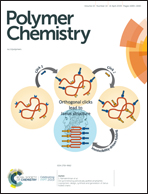De-symmetrizing periodically grafted amphiphilic copolymers: design, synthesis and generation of Janus folded chains†
Abstract
Periodically grafted amphiphilic copolymers (PGACs) were earlier shown to fold in a zigzag fashion to enable segregation of the two immiscible segments, namely the backbone and the pendant segments; crystallization of one or both segments led to the formation of a lamellar structure with the two segments located in alternate layers. In the present study two different pendant segments, namely PEG and fluorocarbon, were installed at periodic intervals in an alternating fashion along a polyethylene-like polyester backbone; the mutual immiscibility between the three different segments, namely backbone alkylene (HC), PEG and fluorocarbon (FC), causes the polymer to fold as earlier, but now the zigzag folded chain would carry fluoroalkyl segments on one side and PEG on the other, thereby generating de-symmetrized Janus-type folded chains. Using DSC, SAXS, WAXS, AFM and FT-IR measurements, we demonstrate the self-segregation and independent crystallization of all three segments, and the formation of a lamellar morphology bearing three different layers. Such layering of three different types of segments in a graft copolymer is unprecedented and could pave the way for interesting applications that require separation of two different functional entities at sub-10 nanometre length scales.



 Please wait while we load your content...
Please wait while we load your content...